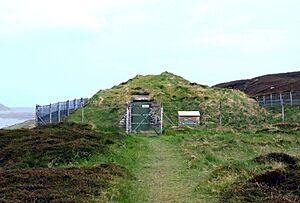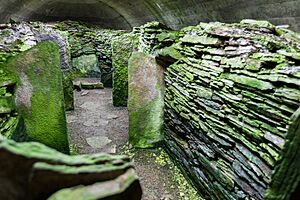Knowe of Yarso chambered cairn facts for kids
The Knowe of Yarso chambered cairn is an ancient burial place from the Neolithic Age. It is located on the island of Rousay in Orkney, Scotland. This special monument was dug up by archaeologists in the 1930s. They found human and animal bones, along with pieces of pottery, flint tools, bone tools, and arrowheads. This tomb was built between 3500 and 2500 BC. It is a type of "stalled chambered cairn," similar to other tombs like Midhowe and Blackhammer. In 1994, Historic Environment Scotland made it a protected historical site.
Exploring Knowe of Yarso: An Ancient Burial Place
This ancient Neolithic burial monument is found on Rousay, an island in Orkney, Scotland. It sits high up on a hill, looking out over the water called Eynhallow Sound. Near the bottom of the same hill, you can find the remains of another tomb called Blackhammer chambered cairn.
Knowe of Yarso was built a very long time ago, between 3500 and 2500 BC. Today, it looks like a large mound covered in grass, with a concrete roof to protect it. This tomb is a special kind of Orkney–Cromarty stalled chambered cairn. This means it has stone slabs inside that divide the main chamber into smaller sections, like stalls. Other similar tombs, Midhowe and Blackhammer, are also on Rousay.
What Archaeologists Found Inside
During the 1930s, archaeologists carefully dug up the Knowe of Yarso. They found that the outside of the cairn was about 15 metres long and 8 metres wide. The burial chamber inside was about 8 metres long and 2 metres wide, and it was still 2 metres high.
The original roof of the tomb was missing. It had likely been removed a long time ago, perhaps when the tomb was robbed. The outer walls of the tomb show beautiful stonework, especially near the entrance. The main burial chamber had four separate areas, divided by pairs of tall stone slabs. You could enter the main chamber through a 4 metre long passage on the southeast side.
Archaeologists made amazing discoveries inside. They found the bones of at least 29 people. They also found bones from 36 deer, several sheep, and even a dog. Besides bones, they uncovered pieces of pottery, four arrowheads, five tools made from bone, and several pieces of flint. Because of its historical importance, Historic Environment Scotland officially protected the site as a scheduled monument in 1994.
See also



